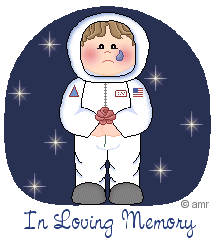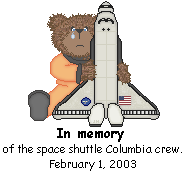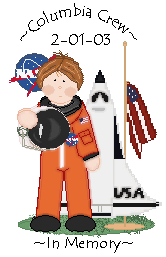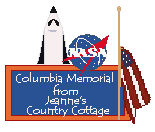Men in
Space
|
On
February 1, 2003, the space shuttle Columbia, the first space
shuttle to fly in orbit, exploded 40 miles above Earth, just
16 min before its scheduled landing, killing its crew of seven
astronauts.
One
week before the disaster, it was the 17th anniversary of the
explosion of the space shuttle Challenger, in which seven astronauts
were also killed. |
 |
 |
Men
has explored space for over 45 years. The term "astronaut"
derives from the Greek words meaning "space sailor,"
and refers to all who have been launched as crew members aboard
NASA spacecraft bound for orbit and beyond. The term "cosmonaut"
refers to those space sailors who are members of the Russian
space program. |
|
The
Sputnik I was the first man-made earth satellite. It was launched
by U.S.S.R. on October, 4 1957 and remained in orbit until January
4, 1958, when it reentered the atmosphere and disintegrated.
The
Sputnik II, the world's second man-made satellite, was launched
by U.S.S.R. on November, 3 1957, carrying a dog named Laika,
and remained in orbit until April 13, 1958. It was the first
vehicle to carry a living organism into orbit.
On
January, 31 1958, Explorer I, the first U.S. earth satellite,
was launched.
Columbia
was NASA's first airplane-like craft. It was delivered to Kennedy
Space Center in March 1979. Columbia initiated the Space Shuttle
flight program when it lifted off at Kennedy Space Center on
April 12, 1981, at 7:00:03 a.m. EST. The shuttle landed successfully
two days later on April 14, 1981, at 10:20:57 a.m. PST. It had
only two crew members (commander John W. Young and pilot Robert
L. Crippen).
From
1981 onwards, space shuttles were sent to space, with the exception
of 1987. The Columbia's last mission was NASA's 113th Space Shuttle
flight to space.
Columbia
was named after a small sailing vessel that operated out of Boston
in 1792 and explored the mouth of the Columbia River. One of
the first ships of the U.S. Navy to circumnavigate the globe
was also named Columbia.
On
January 16, 2003, at 10:39 a.m. EST, Columbia was launched for
the last time with a crew of seven people (Rick Husband, William
McCool, Michael Anderson, David Brown, Laurel Clark, Kalpana
Chawla and Ilan Ramon). It was destroyed over east Texas on its
landing descent to Kennedy Space Center on February 1, 2003,
at 8:59 a.m. EST. |
|
|
Challenger, was
the second orbiter to become operational at Kennedy Space Center.
It was named after the British Naval research vessel HMS Challenger
that sailed the Atlantic and Pacific oceans during the 1870's.
Challenger
joined NASA fleet of reusable winged spaceships in July 1982.
It flew nine successful Space Shuttle missions. |
|
Challenger space
shuttle on its first flight |
|
Challenger's
first flight (the 6th Shuttle Mission to space) was on April
4, 1983, at 1:30:00 p.m. EST. It landed successfully on April
9, 1983, at 10:53:42 a.m. PST.
On
January 28, 1986, the Challenger and its seven-member crew (Dick
Scobee, Michael Smith, Judy Resnik, Elison Onizuka, Ron McNair,
Greg Jarvis and Christa McAullife) were lost 73 seconds after
it lifted off from Florida's Kennedy Space Center, at 11:38 a.m
ET, disintegrating over the Atlantic Ocean , when a booster failure
resulted in the breakup of the vehicle. It was the 25th Shuttle
Mission to space and Challenger's 10th liftoff.
NASA
- National Aeronautics and Space Administration
October
1, 1958, was the official start of NASA. NASA’s first high
profile program was Project Mercury, an effort to learn if humans
could survive in space, followed by Project Gemini. NASA’s
human space flight efforts then extended to the Moon with Project
Apollo, culminating in 1969 when the Apollo 11 mission first
put humans on the lunar surface. NASA' manned programs were:
Mercury, Gemini, Apollo, Skylab, Apollo-Soyuz Test Project, and
the Space Shuttles (Columbia, Challenger, Discovery, Atlantis
and Endeavour).
The
first American space flight involving human beings happened on
May 5, 1961 with the Mercury Program. The first U.S. spaceship
was a cone-shaped one-man capsule with a cylinder mounted on
top. Freedom 7, the first piloted Mercury spacecraft carrying
Astronaut Alan B. Shepard, Jr., was launched from Cape Canaveral.
His flight lasted 14.8 minutes.
On
February 20, 1962, John Glenn became the first American to circle
the Earth, making three orbits aboard Friendship 7 Mercury spacecraft.
The
Mercury Program made 6 flights (from May 5, 1961 to May 16, 1963).
The spaceships that were part of this program were Freedom 7
(May 5, 1961); Liberty Bell 7 (July 21, 1961); Friendship 7 (Feb.
20, 1962); Aurora 7 (May 24, 1962); Sigma 7 (Oct. 3, 1962) and
Faith 7 (May 15-16, 1963). Each of the Mercury spaceships carried
one astronaut only.
The
Gemini Program made 10 flights (from March 23, 1965 to Nov. 15,
1966). Each of the Gemini spacecrafts were built for two astronauts.
The
Apollo Program sent missions to space from October 11, 1968 to
December 19, 1972. It was designed to land humans on the Moon
and bring them safely back to Earth. The Apollo Program included
uncrewed test missions and 11 crewed missions (Apollos 1 - in
which the three-member crew died in an accident before the scheduled
liftoff - 7, 8, 9, 10, 11, 12, 13, 14, 15, 16 and 17). Six of
the Apollo missions (Apollos 11, 12, 14, 15, 16 and 17) landed
men on the lunar surface.
The
11 crewed missions of the Apollo Program include two Earth orbiting
missions, two lunar orbiting missions, a lunar swingby and six
Moon landing missions.
The
first lunar landing mission, Apollo 11 lifted off on July 16,
1969 for a three day trip to the Moon. At 4:18 p.m. EST on July
20, 1969, the Lunar Module named "Eagle" with astronauts
Neil A. Armstrong and Edwin E. Aldrin, landed on the lunar surface
while Michael Collins orbited overhead in the Apollo command
module.
On
January 27, 1967, tragedy struck the Apollo program. Astronauts
Virgil I. "Gus" Grissom, Edward White and Roger Chaffee
died during a blaze inside their Apollo capsule while conducting
a countdown test on January 27, 1967 – three weeks before
their scheduled liftoff from Kennedy Space Center.
After
the tragedy the Apollo spacecraft was redesigned with an emphasis
on fireproof materials. The first piloted Apollo mission, Apollo
7, took place in October 1968.
In
April 1970, Apollo 13 was unable to land on the lunar surface,
and ended in near disaster when oxygen tank 2 exploded 55 hours
into the mission. Using the lunar module as a lifeboat, the three-member
crew was able to return safely to earth.
The
Skylab Program made 3 flights (from May 25, 1973 to Feb. 8, 1974).
Each of the Skylab spacecrafts carried three astronauts, sending
a total of 9 astronauts to space.
The
Apollo-Soyuz Test Project (ASTP) made 1 flight sending 3 men
to space (July 15-24, 1975).
The
5 Space Shuttles (Columbia, Challenger, Discovery, Atlantis and
Endeavour), made from April 12, 1981 to January 16, 2003, a total
of 113 flights, not including Challenger's lift off which ended
in its explosion in 1986.
 |
The
space shuttle Columbia made 29 flights (in 1981, 1982, 1983,
1986, 1989, 1990, 1991, 1992, 1993, 1994, 1995, 1996, 1997, 1998,
1999, 2002 and 2003). |
The
space shuttle Challenger made 9 flights (in 1983, 1984 and 1985)
and one liftoff that ended in the disaster in 1986.
The
space shuttle Discovery made 30 flights (in 1984, 1985, 1988,
1989, 1990, 1991, 1992, 1993, 1994, 1995, 1997, 1998, 1999, 2000
and 2001).
The
space shuttle Atlantis made 26 flights (in 1985, 1988, 1989,
1990, 1991, 1992, 1994, 1995, 1996, 1997, 2000, 2001 and 2002)
The
space shuttle Endeavour made 19 flights (in 1992, 1993, 1994,
1995, 1996, 1998, 2000, 2001 and 2002).
The
Kennedy Space Center, located at the Cape Canaveral Spaceport
in Florida, is the place where the checkout, launch and landing
of the Space Shuttles are done. I was there twice, in 1981 and
in 1984. |
|
|
|
|
My
aunt, her mother-in-law, a cousin and me at Kennedy Space Center,
FL. |
Me
and three cousins at Kennedy Space Center, FL, in July 1984. |
|
|

